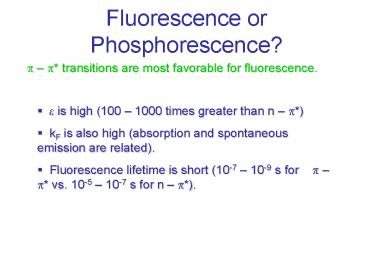Fluorescence or Phosphorescence? - PowerPoint PPT Presentation
1 / 25
Title:
Fluorescence or Phosphorescence?
Description:
Fluorescence or Phosphorescence? p p* transitions are most favorable for fluorescence. e is high (100 1000 times greater than n p*) kF is also high ... – PowerPoint PPT presentation
Number of Views:1093
Avg rating:3.0/5.0
Title: Fluorescence or Phosphorescence?
1
Fluorescence or Phosphorescence?
p p transitions are most favorable for
fluorescence.
- e is high (100 1000 times greater than n
p) - kF is also high (absorption and spontaneous
emission are related). - Fluorescence lifetime is short (10-7 10-9 s
for p p vs. 10-5 10-7 s for n p).
2
Nonaromatic Unsaturated Hydrocarbons
Luminescence is rare in nonaromatic hydrocarbons.
Possible if highly conjugated due to p p
transitions.
Seyhan Ege, Organic Chemistry, D.C. Heath and
Company, Lexington, MA, 1989.
3
Aromatic Hydrocarbons
Fluorescent
Low lying p p singlet state
Phosphorescence is weak because there are no n
electrons
Ingle and Crouch, Spectrochemical Analysis
4
Heterocyclic Aromatics
Aromatics containing carbonyl or heteroatoms are
more likely to phosphoresce
n p promotes intersystem crossing.
Fluorescence is often weaker.
Skoog, Hollar, Nieman, Principles of Instrumental
Analysis, Saunders College Publishing,
Philadelphia, 1998.
5
Aromatic Substituents
- Electron donating groups usually increase fF.
- Electron withdrawing groups usually decrease fF.
Ingle and Crouch, Spectrochemical Analysis
6
Halogen Substituents
Internal Heavy Atom Effect
Promotes intersystem crossing. fF decreases as MW
increases. fP increases as MW increases. tP
decreases as MW increases.
Ingle and Crouch, Spectrochemical Analysis
7
Increased Conjugation
fF increases as conjugation increases. fP
decreases as conjugation increases. Hypsochromic
effect and bathochromic shift.
Ingle and Crouch, Spectrochemical Analysis
8
Rigid Planar Structure
fF 1.0
fF 0.2
fF 0.8
not fluorescent
Ingle and Crouch, Spectrochemical Analysis
Skoog, Hollar, Nieman, Principles of Instrumental
Analysis, Saunders College Publishing,
Philadelphia, 1998.
9
Metals
Metals other than certain lanthanides and
actinides (with f-f transitions) are usually not
themselves fluorescent.
A number of organometallic complexes are
fluorescent.
Skoog, Hollar, Nieman, Principles of Instrumental
Analysis, Saunders College Publishing,
Philadelphia, 1998.
10
Fluorescence and Phosphorescence
Which effect is used more regularly?
SciFinder Scholar Citations
Fluorescence Phosphorescence Labels/Tags
1729 25 Dyes 10612 56
www.wikipedia.org
11
Fluorescence or Phosphorescence Labels?Answer
from a Commercial View
http//www.invitrogen.com/
12
Fluorescence or Phosphorescence Labels?Answer
from a Commercial View
http//www.invitrogen.com/
13
Fluorescence or Phosphorescence?Commercially
Available Phosphorescence Labels
Erythrosin derivative
Eosin derivative
http//www.invitrogen.com/
14
Fluorescence or Phosphorescence?Publications in
Analytical Chemistry
- Fluorescence Phosphorescence
- 1380 106
- Phosphorescence is rarer than fluorescence gt
Higher selectivity. - Phosphorescence Analysis of aromatic compounds
in environmental samples.
15
Solvent Effects
Increased viscosity can increase luminescence
intensity.
H-bonding and dipole interactions with the
solvent contribute to the Stokes shift.
Ashutosh Sharma and Stephen Schulman,
Fluorescence Spectroscopy, John Wiley Sons, New
York, 1999.
16
Solvent Polarity
Increasing solvent polarity usually causes a
red-shift in fluorescence.
http//micro.magnet.fsu.edu/primer/techniques/fluo
rescence/fluorescenceintro.html
17
Solvent Polarity
Joseph Lakowicz, Principles of Fluorescence
Spectroscopy, Kluwer Academic / Plenum
Publishers, New York, 1999.
18
Temperature
Increasing temperature increases ks
Joseph Lakowicz, Principles of Fluorescence
Spectroscopy, Kluwer Academic / Plenum
Publishers, New York, 1999.
19
Decreasing temperature can induce a blue-shift in
fluorescence.
Joseph Lakowicz, Principles of Fluorescence
Spectroscopy, Kluwer Academic / Plenum
Publishers, New York, 1999.
20
Epi-Fluorescence Microscopy
- Light Source - Mercury or xenon lamp (external
to reduce thermal effects) - Dichroic mirror reflects one range of
wavelengths and allows another range to pass. - Barrier filter eliminates all but fluorescent
light.
http//micro.magnet.fsu.edu/primer/techniques/fluo
rescence/fluorosources.html
21
Fluorescence Microscopy
Need 3 filters Exciter Filters Barrier
Filters Dichromatic Beamsplitters
http//microscope.fsu.edu/primer/techniques/fluore
scence/filters.html
22
Are you getting the concept?
You plan to excite catecholamine with the 406 nm
line from a Hg lamp and measure fluorescence
emitted at 470 15 nm. Choose the filter cube
you would buy to do this. Sketch the transmission
profiles for the three optics.
http//microscope.fsu.edu/primer/techniques/fluore
scence/fluorotable3.html
23
Fluorescence Microscopy Objectives
Image intensity is a function of the objective
numerical aperture and magnification
Fabricated with low fluorescence glass/quartz
with anti- reflection coatings
http//micro.magnet.fsu.edu/primer/techniques/fluo
rescence/anatomy/fluoromicroanatomy.html
24
Fluorescence Microscopy Detectors
No spatial resolution required PMT or
photodiode Spatial resolution required CCD
http//micro.magnet.fsu.edu/primer/digitalimaging/
digitalimagingdetectors.html
25
Special Fluorescence Techniques
LIF
TIRF
http//microscopy.fsu.edu/primer/techniques/fluore
scence/tirf/tirfintro.html































